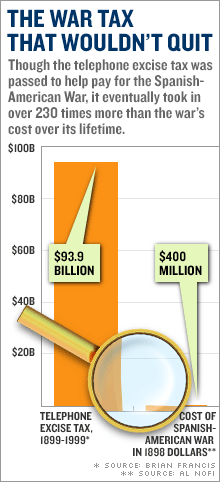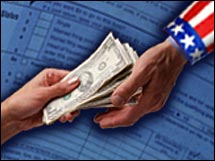|
Remember the Maine? Get a refund
The IRS has had a rough time defending a 3 percent tax on long-distance calls that dates from the Spanish-American War.
NEW YORK (CNNMoney.com) - It's down in an obscure part of your phone bill, and it's been on the books forever, but the telephone excise tax has made a lot of enemies over the years. Although the 3 percent tax on long-distance calls seems like a typical service charge, it's actually an outdated war tax that was passed in 1898 to help pay for the Spanish-American war, say critics.
Major corporations like HP (Research), OfficeMax (Research) and Radio Shack (Research) -- united only by the fact that they have big long-distance bills -- are the latest opponents to take on the tax, arguing in federal court that the tax is only supposed to apply to charges based on the distance and time of the call - and not to modern flat-rate plans, notes a report from Tax Analysts. Unless the IRS can win a circuit court case and a Supreme Court appeal, it's looking like this old tax is on its last legs. And with three class-action suits before various courts, there's the possibility that consumers could soon be eligible for a refund from the IRS. Taxpayers could be due a refund, but that refund would only be for the past three years, which is the statute of limitations on taxes. The IRS has had a rough time defending the tax - its record is a painful one lower-court win and 10 losses, three of them in circuit courts and seven in lower courts. But when would the tax actually be taken off the books? Experts say they can't predict. "Usually the government gives up after two or three circuit court losses," said Tom Sykes, a tax lawyer with McDermott Will & Emery who's covered the telephone excise tax. "Here the IRS has been standing firm and hoping to win one of the active cases it has pending in other circuits so it can go before the Supreme Court." Big moneymaker
To understand why the IRS is so insistent, one only has to look to the tax's revenue - it brought in $5.9 billion in 2005, and is projected to pull in $25.3 billion for the government between 2006 and 2010. The tax was passed in 1898, when there was no federal income tax and telephone service was something that only the rich had access to. It was designed as a luxury tax to help the government during a time of high military spending. After that, every war in the 20th century was used as an excuse to raise or extend the telephone excise tax, according to Stephen Entin, president of the Institute for Research on the Economics of Taxation, in a paper for the Tax Foundation, a think tank which advocates for lower taxation. An excise tax is any charge on an event - as opposed to property - and includes income and sales taxes. Congress passed a bill nixing the tax in 2000 when the federal budget was running a surplus, but former President Clinton vetoed the bill over lost revenue concerns. The Treasury Department has confirmed that it's in discussion with the IRS and Department of Justice about the future of the tax, but it would not say what the discussions concerned nor when a decision was expected. Hitting home
The excise tax shows up on a line buried in your phone bill, usually under the label "access fee" or "federal line charge." If you average, say, a $20 monthly long-distance bill, the tax would be 60 cents a month, or about $22 over three years. If the law is ruled invalid, could you soon be seeing a check in the mail? "Tax refunds happen all the time, but perhaps not on this scale. Every taxpayer that buys landline long-distance has a potential refund claim against IRS," said Sykes. "The problem for ordinary phone subscribers is that they can only reach back three years, and their claim is probably something like $16. Who's going to sit down with their old phone bills and fill out IRS forms for $16?" He said that corporate customers with larger phone bills stood to gain the most from a refund. _________________________ Will the Fed's rate hikes go too far? Full story here.
A new study finds that the Bush tax cuts are making the rich richer. Full story here. |
|



